International Journal of Intelligent Systems and Applications @ijisa
Статьи журнала - International Journal of Intelligent Systems and Applications
Все статьи: 1214
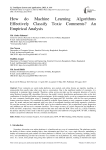
How do Machine Learning Algorithms Effectively Classify Toxic Comments? An Empirical Analysis
Статья научная
Toxic comments on social media platforms, news portals, and online forums are impolite, insulting, or unreasonable that usually make other users leave a conversation. Due to the significant number of comments, it is impractical to moderate them manually. Therefore, online service providers use the automatic detection of toxicity using Machine Learning (ML) algorithms. However, the model's toxicity identification performance relies on the best combination of classifier and feature extraction techniques. In this empirical study, we set up a comparison environment for toxic comment classification using 15 frequently used supervised ML classifiers with the four most prominent feature extraction schemes. We considered the publicly available Jigsaw dataset on toxic comments written by human users. We tested, analyzed and compared with every pair of investigated classifiers and finally reported a conclusion. We used the accuracy and area under the ROC curve as the evaluation metrics. We revealed that Logistic Regression and AdaBoost are the best toxic comment classifiers. The average accuracy of Logistic Regression and AdaBoost is 0.895 and 0.893, respectively, where both achieved the same area under the ROC curve score (i.e., 0.828). Therefore, the primary takeaway of this study is that the Logistic Regression and Adaboost leveraging BoW, TF-IDF, or Hashing features can perform sufficiently for toxic comment classification.
Бесплатно
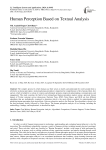
Human Perception Based on Textual Analysis
Статья научная
The complex process by which humans use their senses to clarify and understand the world around them is referred to as human perception. Analyzing human perception is important for comprehension of how humans think, feel, and act, which is helpful in a variety of contexts and ultimately promotes improved understanding, communication, and engagement. This study examines the field of text mining-based human perception analysis using a precisely chosen dataset of Twitter customer service discussions. Decision Trees, KNN, Naive Bayes, and GLM are four different algorithms that are methodically examined to determine which is the most effective method for understanding and predicting human perception from textual data. After an exhaustive analysis, the Decision Tree algorithm is shown to be the best performer, closely followed by Naive Bayes. The human perception analysis of text mining, including the methodology, findings, and implications, is described in depth.
Бесплатно
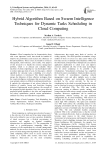
Статья научная
Cloud computing has its characteristics along with some important issues that should be handled to improve the performance and increase the efficiency of the cloud platform. These issues are related to resources management, fault tolerance, and security. The purpose of this research is to handle the resource management problem, which is to allocate and schedule virtual machines of cloud computing in a way that help providers to reduce makespan time of tasks. In this paper, a hybrid algorithm for dynamic tasks scheduling over cloud's virtual machines is introduced. This hybrid algorithm merges the behaviors of three effective techniques from the swarm intelligence techniques that are used to find a near optimal solution to difficult combinatorial problems. It exploits the advantages of ant colony behavior, the behavior of particle swarm and honeybee foraging behavior. Experimental results reinforce the strength of the proposed hybrid algorithm. They also prove that the proposed hybrid algorithm is the best and outperformed ant colony optimization, particle swarm optimization, artificial bee colony and other known algorithms.
Бесплатно
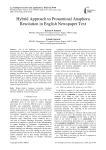
Hybrid Approach to Pronominal Anaphora Resolution in English Newspaper Text
Статья научная
One of the challenges in natural language understanding is to determine which entities to be referred in the discourse and how they relate to each other. Anaphora resolution needs to be addressed in almost every application dealing with natural language such as language understanding and processing, dialogue system, system for machine translation, discourse modeling, information extraction. This paper represents a system that uses the combination of constraint-based and preferences-based architectures; each uses a different source of knowledge and proves effective on computational and theoretical basis, instead of using a monolithic architecture for anaphora resolution. This system identifies both inter-sentential and intra-sentential antecedents of “Third person pronoun anaphors” and “Pleonastic it”. This system uses Charniak Parser (parser05Aug16) as an associated tool, and it relays on the output generated by it. Salience measures derived from parse tree are used in order to find out accurate antecedents from the list of all potential antecedents. We have tested the system extensively on 'Reuters Newspaper corpus' and efficiency of the system is found to be 81.9%.
Бесплатно
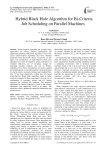
Hybrid Black Hole Algorithm for Bi-Criteria Job Scheduling on Parallel Machines
Статья научная
Nature-inspired algorithms are recently being appreciated for solving complex optimization and engineering problems. Black hole algorithm is one of the recent nature-inspired algorithms that have obtained inspiration from black hole theory of universe. In this paper, four formulations of multi-objective black hole algorithm have been developed by using combination of weighted objectives, use of secondary storage for managing possible solutions and use of Genetic Algorithm (GA). These formulations are further applied for scheduling jobs on parallel machines while optimizing bi-criteria namely maximum tardiness and weighted flow time. It has been empirically verified that GA based multi-objective Black Hole algorithms leads to better results as compared to their counterparts. Also the use of combination of secondary storage and GA further improves the resulting job sequence. The proposed algorithms are further compared to some of the existing algorithms, and empirically found to be better. The results have been validated by numerical illustrations and statistical tests.
Бесплатно

Hybrid Clustering-Classification Neural Network in the Medical Diagnostics of the Reactive Arthritis
Статья научная
In the paper, the hybrid clustering-classification neural network is proposed. This network allows to increase a quality of information processing under the condition of overlapping classes due to the rational choice of learning rate parameter and introducing special procedure of fuzzy reasoning in the clustering-classification process, which occurs both with external learning signal ("supervised"), and without one ("unsupervised"). As similarity measure neighborhood function or membership one, cosine structures are used, which allow to provide a high flexibility due to self-learning-learning process and to provide some new useful properties. Many realized experiments have confirmed the efficiency of proposed hybrid clustering-classification neural network; also, this network was used for solving diagnostics task of reactive arthritis.
Бесплатно
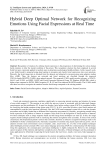
Hybrid Deep Optimal Network for Recognizing Emotions Using Facial Expressions at Real Time
Статья научная
Recognition of emotions by utilizing facial expressions is the progression of determining the various human facial emotions to infer the mental condition of the person. This recognition structure has been employed in several fields but more commonly applied in medical arena to determine psychological health problems. In this research work, a new hybrid model is projected using deep learning to recognize and classify facial expressions into seven emotions. Primarily, the facial image data is obtained from the datasets and subjected to pre-processing using adaptive median filter (AMF). Then, the features are extracted and facial emotions are classified through the improved VGG16+Aquila_BiLSTM (iVABL) deep optimal network. The proposed iVABL model provides accuracy of 95.63%, 96.61% and 95.58% on KDEF, JAFFE and Facial Expression Research Group 2D Database (FERG-DB) which is higher when compared to DCNN, DBN, Inception-V3, R-152 and Convolutional Bi-LSTM models. The iVABL model also takes less time to recognize the emotion from the facial image compared to the existing models.
Бесплатно

Hybrid Flow Shop Scheduling Problem Using Artificial Immune System
Статья научная
Artificial immune system (AIS) is a new technique for solving combinatorial optimization problems. AIS are computational systems that explore, describe and apply different mechanisms inspired by biological immune system in order to solve problems in different domains. In this paper, we propose an algorithm based on the principle of clonal selection and affinity maturation mechanism in an immune response used to solve the Hybrid Flow Shop (FSH) scheduling problem. The parameters in this kind of algorithm play an important role in the quality of solutions in one hand and computer time (CPU) needed another hand. The experimental results have shown the influence of these parameters.
Бесплатно

Hybrid Intelligent Agent-Based Internal Analysis Architecture for CRM Strategy Planning
Статья научная
Nowadays attaining the general and comprehensive information about customers by means of traditional methods is difficult for CEO's because of the agility and complexity of organizations. So they spend a considerable time to gather and analyze the market data and consider it according to the organization's strategy. Presenting a useful architecture that capable to diagnose the organization's advantages and disadvantages, and identify the attainable competitive advantages are the main goals of this paper. The output of such architecture can be a general exhibition of company that prepares a clear and on time comprehensive view for CEO's.
Бесплатно
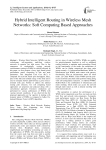
Hybrid Intelligent Routing in Wireless Mesh Networks: Soft Computing Based Approaches
Статья научная
Wireless Mesh Networks (WMNs) are the evolutionary self-organizing multi-hop wireless networks to promise last mile access. Due to the emergence of stochastically varying network environments, routing in WMNs is critically affected. In this paper, we first propose a fuzzy logic based hybrid performance metric comprising of link and node parameters. This Integrated Link Cost (ILC) is computed for each link based upon throughput, delay, jitter of the link and residual energy of the node and is used to compute shortest path between a given source-terminal node pair. Further to address the optimal routing path selection, two soft computing based approaches are proposed and analyzed along with a conventional approach. Extensive simulations are performed for various architectures of WMNs with varying network conditions. It was observed that the proposed approaches are far superior in dealing with dynamic nature of WMNs as compared to Adhoc On-demand Distance Vector (AODV) algorithm.
Бесплатно
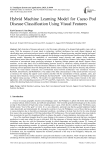
Hybrid Machine Learning Model for Cacao Pod Disease Classification Using Visual Features
Статья научная
Early detection of diseases and pests is vital for proper cultivation of in-demand, high-quality crops, such as cacao. With the emergence of recent trends in technology, artificial intelligence has made disease diagnosis and classification more convenient and non-invasive with the applications of image processing, machine learning, and neural networks. This study presented an alternative approach for developing a cacao pod disease classifier using hybrid machine learning models, integrating the capabilities of convolutional neural networks and support vector machines. Convolutional neural networks were employed to extract complex and high-level features from images, breaking the restrictions of conventional image processing techniques in capturing intricate patterns and details. Support vector machines, on the other hand, excel at differentiating between classes by effectively utilizing distinctive numerical parameters representing datasets with clear interclass differences. Raw images of cacao pods were utilized as inputs for extracting relevant parameters that will distinguish three distinct classes: healthy, black pod rot diseased, and pod borer infested. For visual feature extraction, four convolutional neural network architectures were considered: AlexNet, ResNet50, DenseNet201, and MobileNetV2. The outputs of the fully connected layers of the neural networks were used as references for training the support vector machine classifier with the consideration of linear, quadratic, cubic, and Gaussian kernel functions. Among every hybrid pair, the DenseNet201 – Cubic Kernel Support Vector Machine attained the highest testing accuracy of 98.4%. The model even outperformed two pre-existing systems focused on the same application, with corresponding accuracies of 91.79% and 94%, respectively. Thus, it posed an improved, non-invasive method for detecting black pod rot disease or pod borer infestation in cacao pods.
Бесплатно
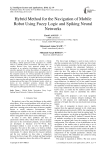
Hybrid Method for the Navigation of Mobile Robot Using Fuzzy Logic and Spiking Neural Networks
Статья научная
The aim of this paper is to present a strategy describing a hybrid approach for the navigation of a mobile robot in a partially known environment. The main idea is to combine between fuzzy logic approach suitable for the navigation in an unknown environment and spiking neural networks approach for solving the problem of navigation in a known environment. In the literature, many approaches exist for the navigation purpose, for solving separately the problem in both situations. Our idea is based on the fact that we consider a mixed environment, and try to exploit the known environment parts for improving the path and time of navigation between the starting point and the target. The Simulation results, which are shown on two simulated scenarios, indicate that the hybridization improves the performance of robot navigation with regard to path length and the time of navigation.
Бесплатно
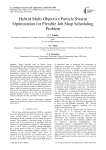
Hybrid Multi-Objective Particle Swarm Optimization for Flexible Job Shop Scheduling Problem
Статья научная
Hybrid algorithm based on Particle Swarm Optimization (PSO) and Simulated annealing (SA) is proposed, to solve Flexible Job Shop Scheduling with five objectives to be minimized simultaneously: makespan, maximal machine workload, total workload, machine idle time & total tardiness. Rescheduling strategy used to shuffle workload once the machine breakdown takes place in proposed algorithm. The hybrid algorithm combines the high global search efficiency of PSO with the powerful ability to avoid being trapped in local minimum of SA. A hybrid multi-objective PSO (MPSO) and SA algorithm is proposed to identify an approximation of the pareto front for Flexible job shop scheduling (FJSSP). Pareto front and crowding distance is used for identify the fitness of particle. MPSO is significant to global search and SA used to local search. The proposed MPSO algorithm is experimentally applied on two benchmark data set. The result shows that the proposed algorithm is better in term quality of non-dominated solution compared to the other algorithms in the literature.
Бесплатно
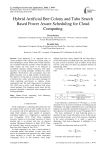
Hybrid artificial bee colony and tabu search based power aware scheduling for cloud computing
Статья научная
Load balancing is an important task on virtual machines (VMs) and also an essential aspect of task scheduling in clouds. When some Virtual machines are overloaded with tasks and other virtual machines are under loaded, the load needs to be balanced to accomplish optimum machine utilization. This paper represents an existing technique “artificial bee colony algorithm” which shows a low convergence rate to the global minimum even at high numbers of dimensions. The objective of this paper is to propose the integration of artificial bee colony with tabu search technique for cloud computing environment to enhance energy consumption rate. The main improvement is makespan 28.4 which aim to attain a well balanced load across virtual machines. The simulation result shows that the proposed algorithm is beneficial when compared with existing algorithms.
Бесплатно

IC Floorplanning Optimization using Simulated Annealing with Order-based Representation
Статья научная
Integrated Circuits (IC) floorplanning is an important step in the integrated circuit physical design; it influences the area, wire-length, delay etc of an IC. In this paper, Order Based (OB) representation has been proposed for fixed outline floorplan with Simulated Annealing (SA) algorithm. To optimize the IC floorplan, two physical quantities have been considered such as area, and wire-length for hard IP modules. Optimization of the IC floorplan works in two phases. In the first phase, floorplans are constructed by proposed representation without any overlapping among the modules. In the second phase, Simulated Annealing algorithm explores the packing of all modules in floorplan to find better optimal performances i.e. area and wire-length. The Experimental results on Microelectronic Center of North Carolina benchmark circuits show that our proposed representation with SA algorithm performs better for area and wire-length optimization than the other methods. The results are compared with the solutions derived from other algorithms. The significance of this research work is improvement in optimized area and wire-length for modern IC.
Бесплатно
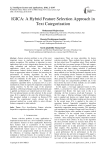
IGICA: A Hybrid Feature Selection Approach in Text Categorization
Статья научная
Feature selection problem is one of the most important issues in machine learning and statistical pattern recognition. This problem is important in many applications such as text categorization because there are many redundant and irrelevant features in these applications which may reduce the classification performance. Indeed, feature selection is a method to select an appropriate subset of features for increasing the performance of learning algorithms. In the text categorization, there are many features which most of them are redundant. In this paper, a two-stage feature selection method-IGICA- based on imperialist competitive algorithm (ICA) is proposed. ICA is a new metaheuristic which is inspired by imperialist competition among countries. At the first stage of the proposed algorithm, a filtering technique using the information gain is applied and features are ranked based on their values. The top ranking features are then selected. In the second stage, ICA is applied to the select the efficient features. The presented method is evaluated on Retures-21578 dataset. The experimental results showed that the proposed method has a good ability to select efficient features compared to other methods.
Бесплатно
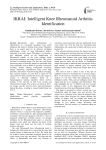
IKRAI: Intelligent Knee Rheumatoid Arthritis Identification
Статья научная
Rheumatoid joint inflammation is characterized as a perpetual incendiary issue which influences the joints by hurting body tissues Therefore, there is an urgent need for an effective intelligent identification system of knee Rheumatoid arthritis especially in its early stages. This paper is to develop a new intelligent system for the identification of Rheumatoid arthritis of the knee utilizing image processing techniques and neural classifier. The system involves two principle stages. The first one is the image processing stage in which the images are processed using some techniques such as RGB to grayscale conversion, rescaling, median filtering, background extracting, images subtracting, segmentation using canny edge detection, and features extraction using pattern averaging. The extracted features are used then as inputs for the neural network which classifies the X-ray knee images as normal or abnormal (arthritic) based on a backpropagation learning algorithm which involves training of the network on 400 X-ray normal and abnormal knee images. The system was tested on 400 x-ray images and the network shows good performance during that phase, resulting in a good identification rate 95.5 %.
Бесплатно

ILSHR Rumor Spreading Model by Combining SIHR and ILSR Models in Complex Networks
Статья научная
Rumor is an important form of social interaction. However, spreading harmful rumors can have a significant negative impact on social welfare. Therefore, it is important to examine rumor models. Rumors are often defined as unconfirmed details or descriptions of public things, events, or issues that are made and promoted through various tools. In this paper, the Ignorant-Lurker-Spreader-Hibernator-Removal (ILSHR) rumor spreading model has been developed by combining the ILSR and SIHR epidemic models. In addition to the characteristics of the lurker group of ILSR, this model also considers the characteristics of the hibernator group of the SIHR model. Due to the complexity of the complex network structure, the state transition function for each node is defined based on their degree to make the proposed model more efficient. Numerical simulations have been performed to compare the ILSHR rumor spreading model with other similar models on the Sina Weibo dataset. The results show more effective ILSHR performance with 95.83% accuracy than CSRT and SIR-IM models.
Бесплатно
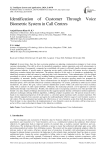
Identification of Customer Through Voice Biometric System in Call Centres
Статья научная
In recent times, there has been a growing emphasis on adjusting communication strategies to foster strong customer relationships. This shift is driven by intensified competition, market maturation, and swift advancements in business technology. Consequently, companies have established call centers to efficiently handle customer support and fulfil customer inquiries. A pivotal aspect of enhancing service quality within these call centers involves accurately identifying customers during their interactions. The primary objective of this study is to introduce a methodology for identifying customers within call centers by analysing their voice characteristics. Voice authentication (VA) has gained prominence in critical security operations, including banking transactions and conversations within call centers. The susceptibility of automatic speaker verification systems (ASVs) to deceptive spoofing attacks has prompted the development of countermeasures (CMs). These countermeasures are designed to differentiate between authentic and fabricated speech. ASVs and CMs collectively constitute contemporary VA systems, positioned as robust access control mechanisms. To achieve this goal, various customer identification systems within call centers have been examined, along with an analysis of audio signal attributes. Ultimately, the manuscript presents a novel approach to customer identification through voice biometrics. Notably, this method excels in recognizing customers even when provided with limited voice data. Empirical findings demonstrate that the suggested speaker identity confirmation method outperforms alternative techniques utilizing different algorithms, exhibiting a higher recognition rate. The present research work is based on two important perspectives of the call centres: a. call center agents experience and b. customer experience. The data collected separately from customers and agents for understanding the effective usage of voice biometric system in call centres. The data represented and satisfies the effectiveness of voice biometric system from both the perspectives. From the data it is also cleared that, the implementation of voice biometric system in call centres still have long way to go but will be a major technological change for the industries worldwide.
Бесплатно
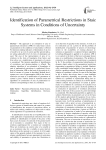
Identification of Parametrical Restrictions in Staic Systems in Conditions of Uncertainty
Статья научная
The approach to an estimation of area of parametrical restrictions (APR) for static linear system on parameters in the conditions of uncertainty is of-fered. For decision-making indicators of domination of an exit of model over an exit of system and the special indicator setting admissible level of errors of domination are used. The case of the representation of area of restrictions in the form of boundaries from below and from above on a modification of parameters of system is considered. The iteration algorithm of identification of restrictions and decision-making is offered. The adaptive algorithm of an estimation of boundaries of area of parametrical restrictions is synthesized. Procedure of estimation APR on the basis of the analysis of a field of secants of system is described. Method development on a case of representation APR in the form of restriction on norm of a modification of parameters of system is given. Various forms of vectorial norms and algorithms of construction of area of parametrical restrictions corresponding to them are considered.
Бесплатно

